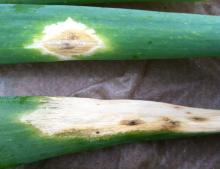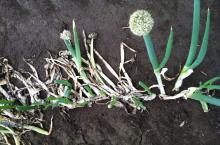See:
Onion (Allium cepa) - Stemphylium Leaf Blight and Stalk Rot
Cause Alternaria porri (syn. = Macrosporium porri), a fungus that overwinters on infected bulbs and debris in the field, can be seedborne in onion. Spores produced on infected plants or crop residues can be dispersed by rain, water, and equipment/workers moving through infected onion fields. Infection often follows injury caused either by other fungi, such as Botrytis, or by sand or dust during windstorms. Older leaves are more susceptible. Moist and warm conditions promote disease. Spore germination requires temperatures between 64°F to 77°F and rain or persistent dew to cause infection. Optimum temperatures for infection are 77°F to 81°F but can occur between 43°F to 93°F. Longer leaf wetness periods are needed at cooler temperatures. The disease sometimes is severe in irrigated fields in eastern Oregon. 'Sweet Spanish' onions are very susceptible.
Symptoms A small, water-soaked lesion develops on leaves and soon develops a white center. Zones may appear as the spot enlarges and the lesion turns brown to purplish. Red or purple margins often encircle the purplish centers and are surrounded by yellowish tissue. In moist weather, the spot's surface usually becomes covered with a brownish black, powdery fungus growth. Leaves with large spots turn yellow and are blown over by the wind.
Bulbs may decay during and after harvest. Decay shows first as a watery rot around the neck and is particularly noticeable because of the yellowish to wine-red discoloration in the neck region. As the fungus moves through onion scales, the tissue turns yellow then a wine-red and dries to a papery texture.
Cultural control
- Use pathogen-free seed.
- Practice long rotations with unrelated crops.
- Reduce hours of leaf wetness by plant spacing and density, as well as irrigation management.
- Destroy old onion cull piles and bury field debris.
- Avoid injuring onions during production.
- Properly cure bulbs in the field; lift and allow them to dry several days before topping.
- Plant tolerant or resistant varieties. 'Fiesta' is tolerant.
Chemical control The disease is not in the Pacific Northwest often enough to warrant an annual spray program. Spray as soon as the disease occurs to prevent further spread.
- Aliette WDG (Group P7; formerly Group 33) at 2 to 3 lb/A on 7- to 14-day intervals. Do not combine within a copper spray program. For dry bulb only. Do not apply within 7 days of harvest. 12-hr reentry.
- Bonide Fung-onil is available for home gardens. H
- Carboxamide (Group 7) formulations are registered for use. Do not make more than two (2) sequential applications before alternating to a labeled fungicide with a different mode of action.
- Endura at 6.8 oz/A on 7- to 14-day intervals. Preharvest interval is 7 days. 12-hr reentry.
- Fontelis at 16 to 24 fl oz/A on 7- to 14-day intervals. Preharvest interval is 3 days. 12-hr reentry.
- Chlorothalonil (Group M5) formulations are labeled.
- Bravo Ultrex at 0.9 to 2.7 lb/A on 7- to 10-day intervals for dry bulbs and at 1.4 to 2.7 lb/A on 7- to 10-day intervals for green bunching onion and onions grown for seed. Do not apply within 7 days of harvest for dry bulb onions and within 14 days of harvest for green bunching onions. 12-hr reentry.
- Echo Zn at 1.5 to 3 pints/A for dry bulb onions and 2 to 4.25 pint/A for green bunching onions on 7- to 10-day intervals. Do not apply within 7 days of harvest for bulb onions and within 14 days of harvest to green bunching onions. 12-hr reentry.
- Copper products (Group M1) are not recommended as stand-alone materials.
- Badge SC at 0.75 to 2.75 pints/A on 7- to 10-day intervals. Preharvest interval is 0 days. 24-hr reentry for greenhouse use; 48-hr reentry for all other applications.
- Bonide Liquid Copper is available for home gardens. H
- Champ Formula 2 at 1.3 pints/A on 7-day intervals. Preharvest interval is 0 days. 48-hr reentry.
- Champ WG at 2 lb/A on 7- to 10-day intervals. 48-hr reentry. O
- Cuprofix Ultra 40 Disperss at 1.25 to 3 lb/A on 7- to 10-day intervals. 48-hr reentry.
- Kocide 2000 at 1.5 lb/A or Kocide 3000 at 0.75 to 1.5 lb/A on 7- to 10-day intervals. 48-hr reentry. O
- Liqui-Cop at 2 teaspoons/gal water. H
- Nu-Cop 50 DF at 2 lb/A on 7- to 10-day intervals. 48-hr reentry. O
- Previsto at 0.75 to 2 quarts/A on 7- to 10-day intervals. 48-hr reentry. O
- Demethylation-inhibiting (DMI) fungicides (Group 3) are labeled for use. Make no more than two (2) sequential applications before alternating to another fungicide with a different mode of action.
- Inspire Super at 16 to 20 fl oz/A on 7- to 10-day intervals. Preharvest interval is 7 days for bulb onions and 14 days for green onions. 12-hr reentry.
- PropiMax EC at 4 fl oz/A on 7-to 10-day intervals. Do not apply within 14 days of harvest for dry bulbs. No preharvest interval for green onion types. 12-hr reentry.
- Tebustar 3.6L at 4 to 6 fl oz/A on 10- to 14-day intervals. Preharvest interval is 7 days. 12-hr reentry.
- Tebuzol 3.6F at 4 to 6 fl oz/A on 10- to 14-day intervals. Do not apply within 7 days of harvest. 12-hr reentry.
- Tilt at 4 to 8 fl oz/A on 7- to 14-day intervals; can use lower rates if tank-mixed, see label for details. Preharvest interval is 14 days for dry bulb onions and 0 days for green onions. 12-hr reentry.
- Topaz at 4 to 8 fl oz/A on 7-to 10-day intervals. Do not apply within 14 days of harvest for dry bulbs. No preharvest interval for green onion types. 12-hr reentry.
- Iprodione formulations (Group 2) are labeled.
- Rovral 4 Flowable at 1.5 pints/A in 50 to 100 gal water for dry bulb onions only. Do not apply within 7 days of harvest. 24-hr reentry.
- Mancozeb (Group M3) formulations are labeled.
- Dithane F45 Rainshield at 2.4 quart/A on 7-day intervals. Do not apply within 7 days of harvest. Can be applied at 1.5 quarts/A on 7- to 10-day intervals for seed crops only in Washington (SLN WA-220008). 24-hr reentry.
- Roper DF Rainshield at 3 lb/A on 7-day intervals can be used on dry bulb onions on 7- to 10-day intervals and at 2 lb/A on 7- to 10-day intervals for Allium seed crops in Washington (SLN WA-1300003). 24-hr reentry.
- Omega 500F (Group 29) at 1 pint/A on 7- to 10-day intervals. Do not use an adjuvant. Preharvest interval is 7 days. 12-hr reentry.
- OSO 5% SC (Group 19) at 3.75 to 13 fl oz/A on 7- to 14-day intervals. Can be applied the day of harvest. 4-hr reentry. O
- Regalia (Group P5) at 1 to 4 quarts/A plus another fungicide on 7- to 14-day intervals. Preharvest interval is 0 days. 4-hr reentry. O
- Scala SC (Group 9) at 9 or 18 fl oz/A when tank-mixed or used alone on 7- to 14-day intervals. When applying alone, do not make more than two (2) consecutive applications of Scala SC before alternating to a fungicide from a different group. Do not apply within 7 days of harvest. 12-hr reentry.
- Strobilurin fungicides (Group 11) are labeled for use. Do not make more than one (1) application of a Group 11 fungicide before alternating to a labeled fungicide with a different mode of action.
- Cabrio EG at 8 to 12 oz/A. Preharvest interval is 7 days. 12-hr reentry.
- Quadris Flowable at 6 to 12 fl oz/A. Preharvest interval is 0 days. 4-hr reentry is 0 days. 4-hr reentry
- Reason 500 SC at 5.5 fl oz/A. Do not apply within 7 days of harvest. 12-hr reentry.
- Vacres at 2.5 to 5 lb/A on 7- to 14-day intervals. Preharvest interval is zero (0) days. 4-hr reentry.
Note: Premixed fungicides are available for use. Do not make more than one (1) application of any Group 11 fungicide before alternating to a labeled fungicide with a different mode of action; for other fungicide groups apply no more than two (2) sequential applications alternating with another fungicide with a different mode of action.
- Aprovia Top (Group 7 + 3) at 10.5 fl oz/A on 7- to 14-day intervals. Preharvest interval is 7 days. 12-hr reentry.
- Dexter Max (Group M3 + 11) at 3.2 lb/A on 7-day intervals for dry bulb onion. Do not apply to exposed bulbs. Pre-harvest interval is 7 days. 24-hr reentry.
- Dexter Xcel (Group M3 + 11 + 3) at 48 to 72 fl oz/A on 7- to 10-day intervals for dry bulb onion. Do not apply to exposed bulbs. Preharvest interval is 7 days. 24-hr reentry.
- Inspire Super (Group 3 + 9) at 16 to 20 fl oz/A on 7- to 10-day intervals with no more than two (2) sequential applications. Preharvest interval is 7 days for bulb onions; 14 days for green onions. 12-hr reentry.
- Luna Tranquility (Group 7 + 9) at 16 to 27 fl oz/A on 7- to 14-day intervals. Do not make more than two (2) applications before alternating to a fungicide in different FRAC groups (non-Group 7 and non-Group 9). Preharvest interval is 7 days. 12-hr reentry.
- ManKocide (Group M1 + M3) at 2.5 lb/A on 7-day intervals. Do not apply within 7 days of harvest. 48-hr reentry.
- Merivon Xemium (Group 7 + 11) at 5.5 to 11 fl oz/A on 7- to 14-day intervals. Do not make more than two (2) applications before alternating to a fungicide in different FRAC groups (non-Group 7 and non-Group 11). Preharvest interval is 7 days. 12-hr reentry.
- Miravis Prime (Group 7 + 12) at 10.3 to 11.4 fl oz/A on 7-day intervals. Preharvest interval is 7 days. 12-hr reentry.
- Orondis Opti (Group M5 + 49) at 1.75 to 2.5 pints/A on 7- to 10-day intervals. Do not apply more than two (2) sequential applications. Preharvest interval is 14 days for green onions, 7 days for dry onions. 12-hr reentry.
- Pristine (Group 7 and 11) at 10.5 to 18.5 oz/A. Preharvest interval is 7 days. 12-hr reentry.
- Quadris Opti (Group 11 + M5) at 1.6 to 3.2 pints/A or Quadris Top at 12 to 14 fl oz/A. Do not apply within 7 days of harvest. 12-hr reentry.
- Quilt Xcel (Group 3 + 11) at 14 to 21 fl oz/A. May be applied the day of harvest for green onion types; 14-day pre-harvest interval for dry bulb onions. 12-hr reentry.
- Switch 62.5 WG (Group 12 + 9) at 11 to 14 oz/A on 7- to 10-day intervals. Do not apply within 7 days of harvest. 12-hr reentry.
- Tanos (Group 11 + 27) at 8 oz/A. Must be tank-mixed with an appropriate fungicide with a different mode of action (non-Group 11 or 27). Preharvest interval is 3 days. 12-hr reentry.
Biological control Efficacy in Oregon unknown.
- Double Nickel LC at 1 to 6 quarts /A on 3- to 10-day intervals. Can be applied the day of harvest. 4-hr reentry. O
- Serenade Opti at 14 to 20 oz/A on 7- to 10-day intervals. Applications can be made up to and the day of harvest. 4-hr reentry. O
References Hoepting, C. A. 2017. Efficacy of fungicide treatments for control of Botrytis leaf blight and Stemphylium leaf blight on onion, 2016. Plant Disease Management Report: Report No. 11:V127.
Hoepting, C. A. 2018. Efficacy of fungicide treatments for control of Stemphylium leaf blight on onion, 2017. Plant Disease Management Report: Report No. 12:V146.
Schwartz, H.F., and Mohan, S.K. 1995. Compendium of Onion and Garlic Diseases. St. Paul, MN: APS Press.



